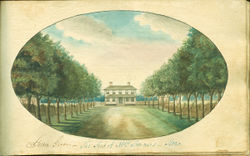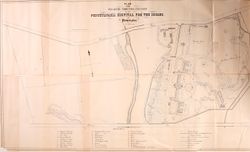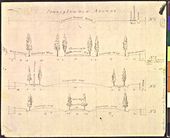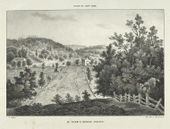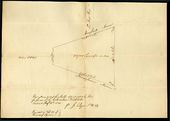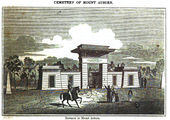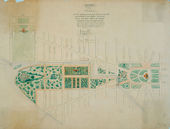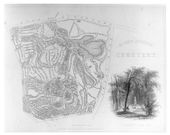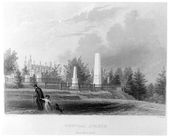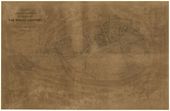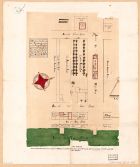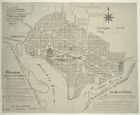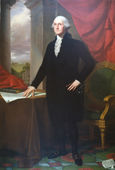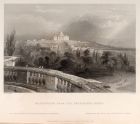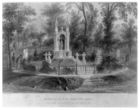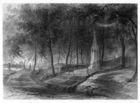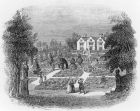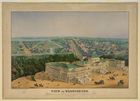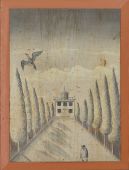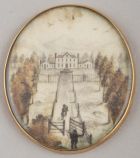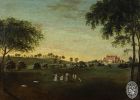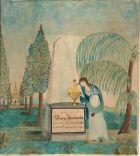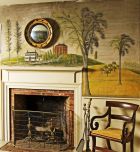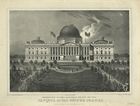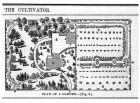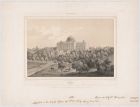Avenue
Discussion
As Noah Webster’s definition states, the word avenue signifies a passage and is rooted in the French word venir (L. vinio), to come or go.
In landscape design an avenue, which was typically planted with trees, varied in scale from a walk to a wide street. From William Byrd II’s 1712 description of Williamsburg, Va., to Rev. Nehemiah Adams’s 1842 account of Boston Common, the avenue has figured prominently in the American designed landscape in a wide range of contexts. An avenue provided an approach to a house, as shown in Charles Fraser’s painting of Golden Grove in South Carolina [Fig. 1]. It served as a public roadway suited to the monumental scale of a governor’s palace, a Native American mound, or a domed capitol. Avenues were also common elements of gardens, public parks, and cemeteries, where they became popular settings for promenades and elegant carriage drives.
. Treatises such as Batty Langley’s New Principles of Gardening (1728) and George William Johnson’s Dictionary of Modern Gardening (1847) extolled the benefits of avenues and emphasized the importance of designing them in relative proportion to surrounding architecture. Images of Pennsylvania Avenue in Washington, D.C. [Fig. 2], and Thomas S. Sinclair’s plan of the Pennsylvania Hospital for the Insane in Philadelphia [Fig. 3] illustrate the variety of American avenues from urban roadways to garden walkways, as well as their corresponding shifts in scale. One of the key characteristics distinguishing avenues from other circulation routes (such as the alley, or path, and road, street, and walk) was their relative size (see Alley and Walk).
Bernard M’Mahon noted in his 1806 treatise that avenues in gardens require “some spacious open space,” and Joseph Holt Ingraham’s 1835 description of a plantation along the Mississippi River differentiated between the broad main avenue and the branching narrower walks. The construction of avenues varied; descriptions mention surfaces of dirt, cobblestone, gravel, and brick. In 1829 the New England Farmer described an avenue in Albany, N.Y., as “McAdamized in the true English style.” The planting of avenues also varied depending on their context. As Ephraim Chambers’ 1741–43 definition suggests, tree plantings were an essential element of an avenue, accentuating its scale and reinforcing its role in directing the gaze. M’Mahon similarly commented in 1806 on the relative merits of deciduous and evergreen trees for avenue plantings. In the warmer climes, trees such as lemon, orange, live oak, and palm were planted along avenues, while in the mid-Atlantic poplar, cherry, lime [or linden], and cedar were popular choices. New England descriptions mention linden, larch, maple, elm, locust, and chestnut trees. A. J. Downing recommended elms, plane trees, horse chestnuts, maples, and tulip trees for avenues. While the spreading branches, such as those described by Adams on Boston Common in 1842, created “ancient shade” and alluded to Gothic architecture, tall narrow trees such as poplar and palm enhanced the straight vistas that avenues created. As David Bailie Warden complained of Washington, D.C., in 1816, however, this vegetation offered little relief from the oppressive heat.
Avenues were typically planted with trees on both sides in single or double rows, although, as Samuel Deane (1790) noted, trees might also be planted on only one side. In contrast to straight rows of trees, Philip Miller (1759) recommended planting avenues in clumps, or as The Complete Farmer (1769) identified them, “platoons,” of seven or nine trees grouped at intervals of 300 feet. Clumped plantings were extolled further by Thomas Whately, who advocated in 1770 that the “modern” winding avenue should be used as an approach to a house because it “commands two sides at once, and throws them both into perspective.” This style of winding avenues and clumped plantings was rarely employed in America until the 1830s and 1840s, when more naturalistic designs can be seen at Mount Auburn Cemetery, and later in 1850 at Mrs. Pratt’s residence in Boston. One early exception was the redesign of the garden at Mount Vernon in the 1780s, in which Washington used serpentine avenues for the approach to the house and planted shrubberies and wildernesses in the bends of the roadway.[1]
Despite Whately’s criticism that straight avenues have “a tedious sameness” and the buildings to which they are “appropriated . . . [are] seldom shewn to advantage,” most American descriptions praised the effect of tree-lined avenues in directing one’s view to a terminal point. George William Johnson’s 1847 discussion of “Avenue” explains how this effect is achieved as the avenue “cuts the scenery directly in two, and reduces all the prospect to a narrow vista.” Such adjectives as “elegant,” “grand,” “noble,” and “handsome” were used repeatedly in descriptions of avenues framing a house, such as that at Nomini Hall in Westmoreland County, Va., which was described in 1774 by Philip Vickers Fithian. The painted door panels of the Thaxter- Lincoln house in Hingham, Mass. [Fig. 4], illustrate this framing effect, as do John Mason’s recollections (c. 1830) of his father’s avenue at Gunston Hall, Va., with its double rows of black heart cherry trees on either side. Jean de La Quintinie (1693) described avenues as “more properly leading to the front of Houses,” and some of the earliest landscaping in Virginia was the construction of avenues aligned with houses’ central axes, as in William Byrd II’s description of the Governor’s Palace at Williamsburg (1712), or seen on the 1701 plan of his own estate of Westover [Fig. 5].
Through the mid-nineteenth century, travelers in the South admired plantation dwelling houses fronted by straight, shaded avenues arched with mature live oaks. It is also interesting to note that despite treatise writers’ repeated assertions that avenues were becoming less fashionable, visitors continued to admire plantings of stately trees, and homeowners, such as Henry Wadsworth Longfellow, still planted avenues in the 1840s. Their lasting visual appeal and the legacy of mature trees have made avenues an enduring element of American design despite shifts in gardening styles.
Urban avenues—created by designers such as Francis Nicholson in Williamsburg; in Annapolis [Fig. 6], and, possibly, in St. Mary’s City, Md.; and Thomas Jefferson and Pierre- Charles L’Enfant in Washington, D.C. [Fig. 7]—were direct imports of eighteenth-century urban design principles.[2] Thomas Twining’s 1796 account of Washington in the early stages of construction detailed how, from the avenues clear cut through the woods, he knew he was in a “metropolitan city.” The imagery of avenues cut through America’s abundant woodlands as a sign of advancing civilization was echoed as late as 1844 in a report about Rochester, N.Y., in the Magazine of Horticulture. The width and unbroken length in American avenues were not only reminiscent of European models, but the feature also carried the same connotations of authority, monumentality, and status. Such a form, which did not deviate for any obstacle, suggested enormous resources and power. The convergence of avenues on a single point, as with the U.S. Capitol depicted in Robert P. Smith’s 1850 view of Washington, D.C. [Fig. 8], reinforced the centrality of the monument and the authority that it represented by controlling both sight lines and movement within the urban fabric. Whether a visiting diplomat, a parading soldier, or protesting citizen, those who experienced the broad swath of Pennsylvania Avenue leading to the domed capitol had no doubt as to the central authority of the city and the nation that it represented. The scale of avenues also made them suited for larger landscape designs of institutional grounds, where they provided shaded walkways and directed views toward significant structures. Examples include the plan for the University of North Carolina of 1795 [Fig. 9] and the plan for the University of Michigan of 1838 [Fig. 10].
-- Elizabeth Kryder-Reid
Images
Inscribed
Batty Langley, "Design of a rural Garden, after the new manner", in New Principles of Gardening (1728), pl. III, opp. p. 208.
Charles W. Harris, "A plan of the situation of ye University, ye ornamental ground, ye adjacent village, the lands belonging to ye trustees together with ye springs," 1795.
Nicholas King, Section of Thomas Jefferson's Design for "Pennsylvania Avenue," 1803.
Benjamin Henry Latrobe, Plan of the Capitol grounds, 1815.
Jacques-Gerard Milbert (artist), Formentin (printer of plates), State of New-York. Mc.Comb's Bridge Avenue, c.1819.
Charles Bulfinch, "Plan of Grounds adjacent to the United States Capitol," 1822.
Robert Mills, "Plan of the Washington Canal," 1831.
Alexander Wadsworth, Plan of Mount Auburn Cemetery, 1831.
Henry Schenck Tanner, "City of Washington," c.1836.
Alexander Jackson Davis, Design for University of Michigan (elevation and plan of building and grounds), c.1838.
Robert Mills, "Plan of the Mall," 1841.
James Smillie (artist), Robert Hinshelwood (engraver), "Bay-Side Avenue, Fern Hill," in Nehemiah Cleaveland, Green-wood Illustrated (1847), opp. p.42.
James Smillie, "Greenwood Cemetery," in Nehemiah Cleaveland, Green-wood Illustrated (1847), flyleaf.
James Smillie, “Mount Auburn Cemetery," in Cornelia W. Walter, Mount Auburn Illustrated (1850 [1847]), frontispiece.
James Smillie (artist), O.J. Hanks (engraver), “View of the Naval Monument (Central Avenue), Mount Auburn Cemetery," in Cornelia W. Walter, Mount Auburn Illustrated (1850 [1847]), opp. p.22.
A.J. Downing, "Plan showing proposed method of laying out the public grounds at Washington," 1851.
A.J. Downing, N. Michler (copied by), "Plan Showing Proposed Method of Laying Out the Public Grounds at Washington." Manuscript copy of Andrew Jackson Downing's plan for the Mall of 1851, 1867.
Associated
Edward Penington (artist), William Fletcher Boogher, "A description of two lotts in the city of Philadelphia..." [detail], 1882 [1698].
Pierre-Charles L'Enfant, "Plan of the City intended for the Permanent Seat of the Government of the United States . . . ," 1791.
Andrew Ellicott (creator), Samuel Hill (engraver), "Plan of the City of Washington in the territory of Columbia," 1792.
Pierre Pharoux, Plan for Esperanza (Speranza), 1794-95.
Andrew Ellicott, "Plan of the City of Washington in the Territory of Columbia," 1795.
Anne-Marguerite-Henriette Rouillé de Marigny Hyde de Neuville, View of the Pennsylvania Avenue Gateway to the Grounds of the President's House, 1818.
Charles Burton, View of the United States Capitol along Pennsylvania Avenue, Washington, D.C., 1824.
J.C. Loudon, Avenues, in An Encyclopaedia of Gardening (1826), p.943, fig.630a-f.
John Smith Rubens, View of Pennsylvania Avenue to the White House from the Capitol, 1834.
John Vanderlyn, George Washington, 1834.
James E. Teschemacher, Pendleton Lithography, "A green-house constructed at the centre of a cottage," in Thomas Green Fessenden and James E. Teschemacher, Horticultural Register and Gardener's Magazine vol. 1 (May 1, 1835), opp. p.157.
W. H. Bartlett, "Washington from the President's House," in Nathaniel Parker Willis, American scenery; or, Land, lake and river illustrations of transatlantic nature, Vol II (1840), opp. p.50.
Thomas Doughty, View of the Capitol, c.1840-1850.
Alexander W. Longfellow, Sketch of the Grounds of the Longfellow Estate, 1844.
James Smillie (artist), John A. Rolph (engraver), "Indian Mound," in Nehemiah Cleaveland, Green-wood Illustrated (1847), opp. p.19.
James Smillie, "Bay-Grove Hill," in Nehemiah Cleaveland, Green-wood Illustrated (1847), opp. p.26.
James Smillie, "Lawn-Girt Hill," in Nehemiah Cleaveland, Green-wood Illustrated (1847), opp. p.61.
James Smillie (artist), W.W. Rice (engraver), "Monument to Miss Charlotte Canda," in Nehemiah Cleaveland, The Rural Cemeteries of America (1855 [1847]), opp. p.8.
James Smillie, “Entrance to the Cemetery" [detail], in Cornelia W. Walter, Mount Auburn Illustrated (1850 [1847]), title page.
James Smillie (artist), John A. Rolph (engraver), “View of the Central Square, Mount Auburn Cemetery," in Cornelia W. Walter, Mount Auburn Illustrated (1850 [1847]), opp. p.61.
- 1067.jpg
James Smillie, “View of the Bowditch Monument, Mount Auburn Cemetery," in Cornelia W. Walter, Mount Auburn Illustrated (1850 [1847]), opp. p.105.
James Smillie (artist), Rice & Buttre (engravers), "View of Oxnard's Monument, Mount Auburn Cemetery" in Cornelia W. Walter, Mount Auburn Illustrated (1850 [1847]), opp. p.116.
Robert P. Smith, View of Washington, c.1850.
- 0620.jpg
Unknown, Elihu Hobart House, 1850.
Edward Sachse, View of Washington, 1852.
Attributed
James Stoddert, A ground plat of the city and port of Annapolis, copy of James Stoddert's map of 1718, 1718 [1743].
Christian Remick, A Prospective View of part of the Commons, c.1768.
Charles Willson Peale, Parnassus, c. 1769.
- 0246.jpg
Claude Joseph Sauthier, A "plan of the town and port of Brunswick, in Brunswick county, North Carolina; surveyed and drawn in April, 1769, by CJ Sauthier," on a scale of 45 fathoms to an inch., 1769.
Winthrop Chandler, Homestead of General Timothy Ruggles, Hardwick, Massachusetts, c.1770-1775.
Ludwig Gottfried von Redeken, A View of Salem in N. Carolina-1787, 1787.
Jonathan Buddington, View of the Cannon House and Wharf, 1792.
Ralph Earl, Captain John Pratt (1753-1824), 1792.
William Clarke, Mrs. Levin Winder (Mary Stoughton Sloss), 1793.
Pierre Pharoux, Aerial View of Park(?), Esperanza, 1794-1795.
- 1296.jpg
Benjamin Henry Latrobe, "Sketch of the House of Mr. Francis Eps on the Appomattox," 1796.
Charles Fraser, "Another View of the Same," 1803.
Francis Guy, Perry Hall from the northwest, c.1805.
George Ropes, Salem Common on Training Day, 1808.
Charles Fraser, "Golden Grove, The Seat of Mrs. Sommers--Stono," 1810.
Benjamin Henry Latrobe, U.S. Capitol and Pennsylvania Avenue before 1814, c.1814-1820.
Joseph Jacques Ramée (artist), J. Klein and V. Balch (engravers), "View of Union College in the City of Schenectady," c.1820.
Rufus Porter and J.D. Poor, Josiah Stone House [also known as the Holsaert House/Cobb House], 1825-1830.
Anthony St. John Baker, "View of the White House," 1826, in Mémoires d’un voyageur qui se repose (1850).
- 0109.jpg
J. B. Neagle, View from the Capitol to the White House along Pennsylvania Avenue, 1834.
William A. Pratt (artist), Charles Fenderich (lithographer), "Elevation of the eastern front of the Capitol of the United States," c.1839.
John J. Thomas, "Plan of a Garden," in The Cultivator 9, no. 1 (Jan. 1842), p.22, fig.8.
Augustus Köllner, "Capitol (west side)," c.1850.
Texts
Common Usage
- Byrd, William, II, 2 February 1712, describing a visit to the Governor’s Palace, Williamsburg, Va. (Colonial Williamsburg Foundation; hereafter CWF)
- “About 11 o’clock I went to see the Governor’s avenue and his great house which pleased him.”
- Anonymous, 1737, describing in the Executive Journals of the Council of Colonial Virginia the proposed improvements to the Governor’s Palace, Williamsburg, Va. (quoted in Lounsbury 1994: 15) [3]
- “Ordered that there be paid to Mr. Philip Finch the sum of ten pounds for laying and planting the Avenue to the Governors House.”
- Pinckney, Eliza Lucas, 1743, in a letter to Miss Bartlett, describing Charleston, S.C. (1972: 62) [4]
- “I . . . cant say one word on the other seats I saw in this ramble, except the Count’s large double row of Oaks on each side the Avenue that leads to the house—which seemed designed by nature for pious meditation and friendly converse.”
- Callender, Hannah, 1762, describing Belmont Mansion, estate of Judge William Peters, near Philadelphia, Pa. (Pennsylvania Magazine of History and Biography 12: 455) [5]
- “A broad walk of English cherry trees leads down to the river. . . . One avenue gives a fine prospect of the City. . . . Another avenue looks to the obelisk.”
- Contemporary Observer [pseud.], 1767, describing the William Trent House, Trenton, N.J. (quoted in Dillon 1987b: 145B) [6]
- “a genteel brick dwelling house . . . with a large handsome staircase and entry . . . a large handsome avenue of English cherry trees.”
- Finlay, Hugh, 2 January 1774, describing a journey through South Carolina (CWF)
- “now and then we see a swamp, consequently a rice plantation . . . we came sometimes to avenues leading from the high road terminated by a farm houses at a quarter, half and sometimes three quarters of a mile distant.”
- Fithian, Philip Vickers, 18 March 1774, describing Nomini Hall, Westmoreland County, Va. (1943: 108–9) [7]
- “Due East of the Great House are two Rows of tall, flourishing, beautiful, Poplars, beginning on a Line drawn from the School to the Wash-House; these Rows are something wider than the House, & are about 300 yards Long, at the Eastermost end of which is the great Road. . . . These Rows of Poplars form an extremely pleasant avenue, & at the Road, through them, the House appears most romantic, at the same time that it does truly elegant.”
- Anonymous, 1778, describing in the South Carolina and American General Gazette a sale in Charleston, S.C. (quoted in Lounsbury 1994: 15) [3] back up to text
- “Magnolia or Laurels fit for Avenues . . . any height from three feet to twenty.”
- Washington, George, 21 March 1785, describing Mount Vernon, plantation of George Washington, Fairfax County, Va. (Jackson and Twohig, eds., 1978: 4:106) [8]
- “Staked up the largest of my Trees in the avenues and Wilderness and Shrubberies to day, which from the softness of the ground & impression made on them by the Wind were leaning.”
- Brissot de Warville, J. P., 1788, describing Mount Vernon, plantation of George Washington, Fairfax County, Va. (1792: 427–28) [9]
- “I hastened to arrive at Mount Vernon. . . . On this rout traverse a considerable wood, and after having passed over two hills, you discover a country house of an elegant and majestic simplicity. It is preceded by grassplats; on one side of the avenue are the stables, on the other a green-house, and houses for a number of negro mechanics.”
- Bartram, William, 1791, describing a residence on St. Simon’s Island, Ga. (1928: 71–72) [10]
- “Following an old highway, now out of repair, across the Savanna, I ascended the sloping green bank, and entered a noble forest of lofty pines, and then a venerable grove of Live Oaks, under whose shady spreading boughs opened a spacious avenue, leading to the former seat of general Oglethorpe, but now the property of capt. Raimond Demere. . . .
- “This delightful habitation was situated in the midst of a spacious grove of Live Oaks and Palms, near the strand of the bay, commanding a view of the inlet. A cool area surrounded the low but convenient buildings, from whence, through the groves, was a spacious avenue into the island, terminated by a large savanna; each side of the avenue was lined with bee-hives, to the number of fifty or sixty; they seemed to be well peopled, and exhibited a lively image of a colony that has attained to a state of power and affluence, by the practice of virtue and industry.”
- Bartram, William, 1791, describing Lake George, Ga. (1928: 101, 104) [10] back up to text
- “From this place we enjoyed a most enchanting prospect of the great Lake George, through a grand avenue, if I may so term this narrow reach of the river, which widens gradually for about two miles, towards its entrance into the lake, so as to elude the exact rules of perspective, and appears of an equal width. . . .
- “On the site of this ancient town, stands a very pompous Indian mount, or conical pyramid of earth, from which runs in a straight line a grand avenue or Indian highway, through a magnificent grove of magnolias, live oaks, palms, and orange trees, terminating at the verge of a large green level savanna.”
- L’Enfant, Pierre-Charles, 22 June 1791, in a report to George Washington describing L’Enfant’s plans for Washington, D.C. (quoted in Caemmerer 1950: 151) [11]
- “[I] made the distribution regular with streets at right angle north-south and east west but afterwards I opened others on various directions as avenues to and from every principal places, wishing by this not merely to contrast with the general regularity nor to afford a greater variety of pleasant seats and prospect as will be obtained from the advantageous ground over the which the avenues are mostly directed but principally to connect each part of the city with more efficacy by, if I may so express, making the real distance less from place to place in menaging on them a reisprocity of sight and making them thus seemingly connected promot a rapide stellement over the whole.”
- L’Enfant, Pierre-Charles, 4 January 1792, from notes on “Plan of the City” describing Washington, D.C. (quoted in Caemmerer 1950: 163–65)[11] back up to text
- “II. Lines or Avenues of direct communication have been devised, to connect the separate and most distant objects with the principal, and to preserve through the whole a reciprocity of sight at the same time. Attention has been paid to the passing of those leading avenues over the most favorable ground for prospect and convenience. . . .
- “Every Grand transverse Avenue, and every principal divergent one, such as the communication from the President’s House to the Congress House etc. are 160 feet in breadth and thus divided:
- 10 feet of pavement on each side . . . . . . 20
- 30 feet of gravel walk planted
- with trees on each side . . . . . . . . . . . . . . 60
- 80 feet in the middle for carriage way . . 80
- 160 feet. . . .
- “H. Grand Avenue, 400 feet in breadth, and about a mile in length, bordered with gardens, ending in a slope from the houses on each side. This Avenue leads to Monument A and connects the Congress Garden with the
- “I. President’s park and the
- “K. well-improved field.”
- Bailey, Francis, 1796, describing Washington, D.C. (quoted in Reps 1965: 257) [12]
- “The truth is, that not much more than one-half the city is cleared:—the rest is in woods; and most of the streets which are laid out are cut through these woods, and have a much more pleasing effect now than I think they will have when they shall be built; for now they appear like broad avenues in a park, bounded on each side by thick woods; and their being so many of them, and proceeding in so many various directions, they have a certain wild, yet uniform and regular appearance, which they will lose when confined on each side by brick walls.”
- Twining, Thomas, 27 April 1796, describing Washington, D.C. (1894: 100–102) [13]
- “After some time this indistinct way assumed more the appearance of a regular avenue, the trees here having been cut down in a straight line. Although no habitation of any kind was visible, I had no doubt but I was now riding along one of the streets of the metropolitan city. I continued in this spacious avenue for half a mile, and then came out upon . . . the centre of the city. . . . Looking from where I now stood I saw on every side a thick wood pierced with avenues in a more or less perfect state . . . all the avenues converged to that point.”
- Davis, John, 1798–1802, describing Ocean Plantation, property of Thomas Drayton, Jasper County, S.C. (quoted in Jones 1957: 79) [14]
- “To form an idea of Ocean Plantation, let the reader picture to his imagination an avenue of several miles, leading from the Savannah road, through a continued forest, to a wooden-house, encompassed by rice-grounds, corn and cotton fields.”
- Anonymous, 1815, describing in the Georgia Journal the improvements of the Capitol in Milledgeville, Ga. (quoted in Lounsbury 1994: 292) [3] back up to text
- “[Improvements included] the enclosure of the State-House square and avenues of trees planted in it, which in a few years will form an agreeable and beautiful prominade [sic].”
- Warden, David Bailie, 1816, describing Washington, D.C. (quoted in Junior League of Washington 1977: 100) [15]
- “It is deeply to be regretted that the government or corporation did not employ some means for the preservation of the trees which grew on places destined for the public walks. How agreeable would have been their shade along the Pennsylvania Avenue where the dust so often annoys, and the summer sun, reflected from the sandy soil, is so oppressive. The Lombardy poplar, which now supplies their place, serves more for ornament than shelter.”
- Anonymous, 1825, describing South Carolina (quoted in Schwaab 1973: 184) [16]
- “Many of the country seats of the rich planters are elegant; the beautiful avenues of live-oak, which lead from the road to the doors of the mansions tend to give a grand and beautiful effect to the whole.”
- S., J. W., September 1829, describing André Parmentier’s horticultural and botanical garden, Brooklyn, N.Y. (quoted in Gardener’s Magazine, 8: 2)
- “To the left of the garden, an avenue leads to a rustic arbour, in the grotesque style, constructed of the crooked limbs of trees in their rough state, covered with bark and moss.”
- Anonymous, 4 September 1829, “Country Seats Near New York,” describing a farm near Albany, N.Y. (New England Farmer 8: 53)
- “An avenue, McAdamized in the true English style, leads through a rich and extensive lawn to the mansion, which is finely shaded with aged elms, locust and chestnut.”
- Trollope, Frances Milton, 1830, describing New York, N.Y. (1832: 2:158) [17]
- “From hence [the battery] commences the splendid Broadway, as the fine avenue is called, which runs through the whole city.”
- Committee of the Pennsylvania Horticultural Society, 1830, describing Sweet Briar, seat of Samuel Breck, vicinity of Philadelphia, Pa. (quoted in Boyd 1929: 425) [18]
- “Several native lime trees (Tilia Americana and Tilia Europaea) are planted along the avenue, exhibiting a remarkable difference in appearance; the first retaining its foliage in full vigour until the 15th of October, whilst the latter sheds its leaves as early as the 10th of August, and some years even in July.”
- Mason, General John, c. 1830, describing Gunston Hall, seat of George Mason, Mason Neck, Va. (quoted in Rowland 1964: 1:98) [19]
- “On the north front by which was the principal approach, was an extensive lawn kept closely pastured, through the midst of which ran a spacious avenue, girded by long double ranges of that hardy and stately cherry tree, the common black heart, raised from the stone, and so the more fair and uniform in their growth, commencing at about two hundred feet from the house and extending thence for about twelve hundred feet; the carriage way being in the centre and the footways on either side, between the two rows, forming each a double range of trees, and under their shade.
- “But what was remarkable and most imposing in this avenue was that the four rows of trees being to be so alligned as to counteract that deception in our vision which, in looking down long parallel lines makes them seem to approach as they recede; advantage was taken of the circumstance and another very pleasant delusion was effected. A common centre was established exactly in the middle of the outer doorway of the mansion, on that front, from which were made to diverge at a certain angle the four lines on which these trees were planted, the plantation not commencing but at a considerable distance therefrom (about two hundred feet as before mentioned) and so carefully and accurately had they been planted, and trained and dressed in accordance with the other, as they progressed in their growth, that from the point described as taken for the common centre, and when they had got to a great size, only the first four trees were visible.”
- Story, Joseph, 24 September 1831, describing Mount Auburn Cemetery, Cambridge, Mass. (p. 29) [20]
- “The grounds of the Cemetery have been laid out with intersecting avenues, so as to render every part of the wood accessible. These avenues are curved and variously winding in their course, so as to be adapted to the natural inequalities of the surface. By this arrangement, the greatest economy of the land is produced, combining at the same time the picturesque effect of landscape gardening. Over the more level portions, the avenues are made twenty feet wide, and are suitable for carriage roads.” [Fig. 11]
- Dearborn, H.A.S., 30 September 1831, describing Mount Auburn Cemetery, Cambridge, Mass. (quoted in Ward 1831: 47) [21]
- “As the tract which has been solemnly consecrated, by religious ceremonies, as a burial-place forever, is so abundantly covered with forest trees, many of which are more than sixty years old, it only requires the avenues to be formed . . . to put the grounds in a sufficiently complete state for the uses designed, and to render them at once beautiful and interesting.”
- Dearborn, H.A.S., 1832, describing Mount Auburn Cemetery, Cambridge, Mass. (quoted in Harris 1832: 76) [22]
- “The approach from the main road leading to Watertown, was by a broad and umbrageous avenue to the foot of the hill, which closes the dale of consecration on the north. . . . In the rear, under the shade of a stately grove of walnuts, where the main avenue divides and gracefully sweeps round the lofty hills to the east and west, the company [attending the consecration] descended from their carriages, and entered the secluded and romantic silvan theatre, by two foot paths, which wound through lonely vales of arching verdure.”
- Legare, John, 1833, describing southern Georgia (quoted in Schwaab 1973: 254) [16] back up to text
- “We were much pleased with the construction and arrangement of the negro houses, they are built on parallel rows, facing each other, and extending some distance, forming a wide avenue or street, which if we recollect aright, is planted throughout with trees. In the rear of the houses are the small gardens and hen houses of the occupants.”
- Ingraham, Joseph Holt, 1835, describing the villas and gardens along the Mississippi River (1:230–31) [23]
- “An hour’s drive, after clearing the suburbs, past a succession of isolated villas, encircled by slender columns and airy galleries, and surrounded by richly foliaged gardens, whose fences were bursting with the luxuriance which they could scarcely confine, brought us in front of a charming residence situated at the head of a broad, gravelled avenue, bordered by lemon and orange trees, forming in the heat of summer, by arching naturally overhead, a cool and shady promenade. We drew up at the massive gate-way and alighted. . . .
- “From this point [around the semi-circular flight of steps, ascending to the piazza of the dwelling] the main avenue branches to the right and left, into narrower, yet not less beautiful walks, which, lined with evergreen and flowering shrubs, completely encircled the cottage.”
- Breck, Joseph, 1 February 1836, “Gardens, Hothouses, &c., in the vicinity of Boston,” describing Bellmont Place, residence of John Perkins Cushing, Watertown, Mass. (Horticultural Register 2: 43)
- “The approach to the mansion from the road is by a winding avenue through a fine grove of ancient deciduous trees. The first view of the garden and ranges of glass structure, as we emerged from the grove, was truly magnificent.”
- MacDonald, James, October 1839, describing the Bloomingdale Asylum for the Insane, New York, N.Y. (quoted in Hawkins 1991: 86) [24]
- “The approach to the Asylum from the southern entrance, by the stranger who associates the most sombre scenes with a lunatic hospital, is highly pleasing. The sudden opening of the view, the extent of the grounds, the various avenues gracefully winding through so large a lawn; the cedar hedges, the fir, and other ornamental trees, tastefully distributed or grouped, the variety of shrubbery and flowers; in fine, the assemblage of so many objects to please the eye, and relieve the melancholy mind from its sad musings, strike him as one of the most successful and useful instances of landscape gardening.”
- Mills, Robert, c. 1841, in a letter to Robert Dale Owen, describing the proposed Smithsonian Institution, Washington, D.C. (Scott, ed., 1990: n.p.) [25]
- “Three spacious avenues (of the city) center within these grounds, which at some future day when improved will form three interesting vistas.”
- Mills, Robert, 23? February 1841, in a letter to Joel R. Poinsett, describing a design for the national Mall, Washington, D.C. (Scott, ed., 1990: n.p.) [25] back up to text
- “The relative position of the Capitol, President’s House, and other public buildings are laid down, as also the position of the proposed building for the Institution; the adjacent streets and avenues are also shown, with the line of the Canal which courses through the City, at the foot of the Capitol hill to the Eastern Branch near the Navy Yard, thus making of the south western section, a complete island.” [Fig. 12]
- Adams, Rev. Nehemiah, 1842, describing Boston Common, Boston, Mass. ([Adams] 1842: 14–15) [26]
- “The trees on the eastern side of the Common. . . . The walk through their ancient shade is not surpassed in interest by any place of public resort, it is not too much to say, in this or any land. When their limbs are bare, a perspective view of them gives as good a representation of Gothic architecture as man ever copied. . . . It requires no history to show the most unpractised eye that Gothic architecture was borrowed from such places as the avenue under those arching elms.”
- W., February 1842, “An Account of Lowell Cemetery,” Lowell, Mass. (Magazine of Horticulture 8: 49)
- “Of the architectural department there is much to admire. One of the avenues, called “Washington Avenue,” embraces a circuit round the ground, and the whole extent of drive is a mile and a half.
- “Directly opposite the gateway, and winding along the side of a natural ridge, leading to the chapel, is “Fenelon Avenue.” From the chapel, the avenues diverge, one extending along the central parts, and intersects with others at right angles: these avenues, for the most part, are bordered by fine forest trees, of a variety of kinds and sizes.”
- Hovey, C. M., April 1842, “Notes made during a Visit to New York, Philadelphia, Baltimore, & c.,” describing the U.S. Capitol, Washington, D.C. (Magazine of Horticulture 8: 127)
- “The Grounds of the Capitol, which should judge contain about twenty acres, are situated upon an eminence which commands a fine view of the surrounding country, and are laid out with broad avenues of various widths, which intersect one another, and lead to the steps of the Capitol. The main entrance to the west front is from Pennsylvania Avenue, where the grounds form a semicircle, of which the avenue is the centre; a very broad walk leads from them, up the ascending surface, to the main steps, which descend from a broad semi-circular terrace. . . .
- “The grounds on the other side, or east front, form nearly a square, laid out with two avenues through the centre, and a broad walk running round the whole, with a belt of trees, which forms the boundary line. On each side of the centre avenues rows of trees are planted, and upon the grass lawns which intervene between the centre and outer walks, are two large circles of dug ground, planted with shrubs, dahlias, and other flowers.”
- Longfellow, Fanny, c. 1844, describing the Vassall-Craigie-Longfellow House, Cambridge, Mass. (quoted in Evans 1993: 38) [27]
- “They [Henry Wadsworth Longfellow and Alexander W. Longfellow] contrived together to plant a linden avenue in which my poet intends to pace in his old age, and compose under its shade, resigning to me all the serpentine walks, where, in the abstraction of inspiration, he might endanger his precious head against a tree. This runs along the northern boundary, and it is to be hoped will be useful, moreover, in screening us from any unsightly buildings Mr. Wyeth may adorn his grounds with.” [Fig. 13]
- B., P., January 1844, “Progress of Horticulture in Rochester, N.Y.” (Magazine of Horticulture 10: 17)
- “Flower gardens and shrubberies are no longer objects of amazement; avenues of forest trees are not uncommon sights in the vicinity of dwellings; in fact the general neatness that pervades this beautiful section of country cannot fail to suggest to the traveller the steady march of taste and refinement, and the progress, though slow, of that art that transforms the wildest forest into a very Eden.”
- Cleaveland, Nehemiah, 1847, describing Greenwood Cemetery, Brooklyn, N.Y. (pp. iii, v)[28]
- “Its numerous avenues furnish a long and delightful drive, presenting, continually, scenes of varied beauty.
- “Avenues have been opened through every part of the ground, and converted, at great expense, into broad and durable carriage-roads.”
- Walter, Cornelia W., 1847, describing Mount Auburn Cemetery, Cambridge, Mass. (p. 14) [29]
- “The avenues are winding in their course and exceedingly beautiful in their gentle circuits, adapted picturesquely to the inequalities of the surface of the ground, and producing charming landscape effects from this natural arrangement, such as could never be had from straightness or regularity. . . .
- “The gateway of Mount Auburn opend from what is known as the north boundary line of the Cemetery. This avenue forms a wide carriage-road, and is one of the most beautiful openings ever improved for such a purpose. With the exception of the necessary grading, levelling, and cutting done of the brushwood, and the planting of a few trees, it has been left as Nature has made it. On either side it is overshadowed by the foliage of forest-trees, firs, pines, and other evergreens; and here you first begin to see the monuments starting up from the surrounding verdure, like bright remembrances from the heart of earth.”
- Downing, A. J., October 1847, describing Montgomery Place, country home of Mrs. Edward (Louise) Livingston, Dutchess County, N.Y. (quoted in Haley 1988: 45) [30]
- “On the east it [the natural boundary of the estate] touches the post road. Here is the entrance gate, and from it leads a long and stately avenue of trees, like the approach to an old French chateau. Halfway up its length, the lines of planted trees give place to a tall wood, and this again is succeeded by the lawn, which opens in all its stately dignity, with increased effect, after the deeper shadows of this vestibule-like wood.”
- Notman, John, 1848, describing his designs for the Hollywood Cemetery, Richmond, Va. (quoted in Greiff 1979: 143) [31]
- “I have not named on the plan the roads or avenues, as it is common to do, after trees and plants, such as Elm Avenue, Magnolia Avenue and so on; this has been done at Mount Auburn, and I think in Greenwood and also Greenmount Cemeteries; but would suggest that they be called after the name of the first person who shall erect a handsome monument or family tomb, or to whom such shall be erected.”
- Kirkbride, Thomas S., April 1848, describing pleasure grounds and farm of the Pennsylvania Hospital for the Insane, Philadelphia, Pa. (American Journal of Insanity 4: 348)
- “The remainder of the grounds on this side of the deer-park is specially appropriated to the use of the male patients. In this division is a fine grove of large trees, several detached clumps of various kinds and a great variety of single trees standing alone or in avenues along the different walks, which, of brick, gravel or tan, are for the men, more than a mile and a quarter in extent. The groves are fitted up with seats and summer houses, and have various means of exercise and amusement connected with them.”
- Eppes, Francis, c. 1850, describing Eppington, plantation of Francis Eppes, on the James River, Va. (quoted in Weaver 1969: 31) [32]
- “The mansion . . . was almost imbedded in a beautiful double row of the tall Lombardy poplar—the most admired of all trees in the palmy days of old Virginia—and this row reached to another double row or avenue which skirted one side of the lawn, dividing it from the orchard and stables.”
- Hovey, C. M., February 1850, “Notes on Gardens and Gardening in the neighborhood of Boston,” describing the residence of Mrs. Pratt, near Boston, Mass. (Magazine of Horticulture 16: 53)
- “The house is approached by a very beautiful drive, winding gracefully through the trees, forming a sort of serpentine avenue, after the Reptonian fashion.”
- Londoniensis [pseud.], October 1850, “Notes and Recollections of a Visit to the Nurseries of Messrs. Hovey & Co., Cambridge” (Magazine of Horticulture 16: 444)
- “The approach from the gate, on reaching this conservatory, diverges east and west at right angles. That on the left entering an avenue of maples, about thirty feet high, and hung to the very ground with branches, so that their stems are entirely hidden by the umbrageous foliage. This avenue runs through the nursery, about a quarter mile in length. . . . This extremity of the avenue opens on another broad street to the city, and forms another entrance to the grounds. Nothing can exceed the beauty of this avenue; and I am astonished that the landed proprietors of this country do not take the example which is here given them, and adorn their demesnes with avenues like this. But they like better to cut down avenues here than to plant them. To tell you the truth, I have never seen anything so grand as this in the middle of a nursery, either here or in England.”
- Hovey, C. M., October 1850, “Notes on Gardens and Nurseries,” describing a residence in Cambridge, Mass. (Magazine of Horticulture 16: 462)
- “The main avenue has been planted with a row of fine Scotch larch, on each side, and the effect, when they get well established, will be excellent.”
- Watson, John Fanning, 1857, describing Wilton, property of Joseph Turner, near Philadelphia, Pa. (2:478) [33]
- “Many statues of fine marble [sold from a Spanish prize] were distributed through the grounds and avenues.”
Watson, John Fanning, 1857, describing Bush Hill, estate of Lt. Gov. James Hamilton, near Philadelphia, Pa. (2:479) [25] back up to text
- “In the rear were avenues of stately cedars—some few still remaining; and in the front was a charmingly graceful descending green lawn, gradually sloping down to Vine street.”
Citations
Notes
- ↑ Dennis J. Pogue, “Mount Vernon: Transformation of an Eighteenth-Century Plantation System,” in Historical Archaeology of the Chesapeake, ed. Paul A. Shackel and Barbara J. Little (Washington, D.C.: Smithsonian Institution Press, 1994), 101–14. Although Washington and J. P. Brissot de Warville referred to the roadways as “avenues,” other descriptions called them walks. view on Zotero
- ↑ John W. Reps, The Making of Urban America: A History of City Planning in the United States (Princeton, N.J.: Princeton University Press, 1965). For a discussion of the design of St. Mary’s City, Md., see Henry Miller, “Baroque Cities in the Wilderness: Archaeology and Urban Development in the Colonial Chesapeake,” Historical Archaeology 22, no. 2 (1988): 57–73. view on Zotero
- ↑ 3.0 3.1 3.2 Lounsbury, Carl R., ed. 1994. An Illustrated Glossary of Early Southern Architecture and Landscape. New York: Oxford University Press. view on Zotero
- ↑ Pinckney, Eliza Lucas. 1972. The Letterbook of Eliza Lucas Pinckney, 1739–1762. Edited by Elise Pinckney. Chapel Hill: University of North Carolina Press. view on Zotero
- ↑ Vaux, George. 1888. “Extracts from the Diary of Hannah Callender.” Pennsylvania Magazine of History and Biography 12 (1): 432–56. view on Zotero
- ↑ Dillon, Clarissa F. 1987. “‘A Large, an Useful, and a Grateful Field’: Eighteenth-Century Kitchen Gardens in Southeastern Pennsylvania, the Uses of the Plants, and Their Place in Women’s Work”. Ph.D. diss., Bryn Mawr College. view on Zotero
- ↑ Fithian, Philip Vickers. 1943. Journal & Letters of Philip Vickers Fithian, 1773-1774: A Plantation Tutor of the Old Dominion. Edited by Hunter D. Farish. Williamsburg, Va.: Colonial Williamsburg. view on Zotero
- ↑ Jackson, Donald, and Dorothy Twohig, ed. 1976. The Diaries of George Washington. 6 vols. Charlottesville, Va.: University Press of Virginia. view on Zotero
- ↑ Brissot de Warville, J.-P. (Jacques-Pierre). 1792. New Travels in the United States Performed in 1788. New York: T. & J. Swords. view on Zotero
- ↑ 10.0 10.1 Bartram, William. 1928. Travels through North and South Carolina, Georgia, East and West Florida. Edited by Mark Van Doren. New York: Dover. view on Zotero
- ↑ 11.0 11.1 Caemmerer, H. Paul. 1950. The Life of Pierre-Charles L’Enfant, Planner of the City Beautiful, The City of Washington. Washington, D.C.: National Republic. view on Zotero
- ↑ Reps, John W. 1965. The Making of Urban America: A History of City Planning in the United States. Princeton, N.J.: Princeton University Press. view on Zotero
- ↑ Twining, Thomas. 1894. Travels in America 100 Years Ago. New York: Harper. view on Zotero
- ↑ Jones, Katharine M. 1957. The Plantation South. New York: Bobbs-Merrill. view on Zotero
- ↑ Junior League of Washington. 1977. The City of Washington: An Illustrated History. New York: Alfred A. Knopf. view on Zotero
- ↑ 16.0 16.1 Schwaab, Eugene L., and Jacqueline Bull. 1973. Travels in the Old South. Lexington: University Press of Kentucky. view on Zotero
- ↑ Trollope, Frances. 1832. Domestic Manners of the Americans. 3rd ed. 2 vols. London: Wittaker, Treacher. view on Zotero
- ↑ Boyd, James. 1929. A History of the Pennsylvania Horticultural Society, 1827-1927. Philadelphia: Pennsylvania Horticultural Society. view on Zotero
- ↑ Rowland, Kate Mason. 1964. The Life of George Mason: 1725-1792. 2 vols. New York: Russell and Russell. view on Zotero
- ↑ Story, Joseph. 1831. An Address Delivered on the Dedication of the Cemetery at Mount Auburn. Boston: Joseph T. and Edwin Buckingham. view on Zotero
- ↑ Ward, Malthus A. 1831. An Address Pronounced Before the Massachusetts Horticultural Society. Boston: J. T. & E. Buckingham. view on Zotero
- ↑ Harris, Thaddeus William. 1832. A Discourse Delivered before the Massachusetts Horticultural Society on the Celebration of Its Fourth Anniversary, October 3, 1832. Cambridge, Mass.: E. W. Metcalf. view on Zotero
- ↑ Ingraham, Joseph Holt. 1835. The South-west. 2 vols. New York: Harper. view on Zotero
- ↑ Hawkins, Kenneth. 1991. “The Therapeutic Landscape: Nature, Architecture, and Mind in Nineteenth-Century America”. Ph.D. diss., University of Rochester. view on Zotero
- ↑ 25.0 25.1 25.2 Scott, Pamela, ed. 1990. The Papers of Robert Mills. Wilmington, Del.: Scholarly Resources. view on Zotero
- ↑ Adams, Nehemiah. 1842. Boston Common. Boston: William D. Ticknor and H. B. Williams. view on Zotero
- ↑ Evans, Catherine. 1993. Cultural Landscape Report for Longfellow National Historic Site, History and Existing Conditions. Vol. 1. Boston: National Park Service, North Atlantic Region. view on Zotero
- ↑ Cleaveland, Nehemiah. 1847. Green-wood Illustrated: In Highly Finished Line Engraving, from Drawings Taken on the Spot/by James Smillie/With Descriptive Notices, by Nehemiah Cleaveland. New York: R. Martin. view on Zotero
- ↑ Walter, Cornelia W. 1847. Mount Auburn Illustrated in a Series of Views from Drawings by James Smillie. New York: Martin and Johnson. view on Zotero
- ↑ Haley, Jacquetta M., ed. 1988. Pleasure Grounds: Andrew Jackson Downing and Montgomery Place. Tarrytown, N.Y.: Sleepy Hollow Press. view on Zotero
- ↑ Greiff, Constance. 1979. John Notman, Architect, 1810-1865. Philadelphia: Athenaeum of Philadelphia. view on Zotero
- ↑ Weaver, Bettie Woodson. 1969. “Mary Jefferson and Eppington.” Virginia Cavalcade 19 (autumn): 30–38. view on Zotero
- ↑ Watson, John Fanning. 1857. Annals of Philadelphia and Pennsylvania in the Olden Time; Being a Collection of Memoirs, Anecdotes, and Incidents of the City and Its Inhabitants, and of the Earliest Settlements of the Inland Part of Pennsylvania, from the Days of the Founders. 2 vols. Philadelphia: E. Thomas. view on Zotero
